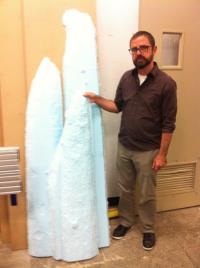Drexel Digital Media Collaborates with Independence Seaport Museum on 'Difficult Journey Home’ Animation
The latest collaboration in a 14-year relationship between Drexel’s Department of Digital Media and the Independence Seaport Museum is an animation recreating the perilous 1921 journey of the USS Olympia.
July 8, 2021
The exhibition, Difficult Journey Home at the Independence Seaport Museum in Philadelphia, Pennsylvania, celebrated the Centennial Anniversary of the Unknown Soldier’s journey home aboard Cruiser Olympia from Le Havre, France, to the United States on the way to his final resting place, Arlington National Cemetery in 1921 after World War I. In a collaboration between the museum and Drexel University’s Animation and Visual Effects program, a group of undergraduate students led by Assistant Teaching Professor Daniel Rose created the animation Difficult Journey Home showcased during the exhibition, sharing the story of the USS Olympia’s mission to bring the Unknown Soldier home. The animation shed light on the perils the USS Olympia went through during her voyage through a category four hurricane. While the rain was light and the storm was mild, the seas were extremely rough. Some accounts reported that the USS Olympia rolled 39 degrees, 10 degrees shy of being lost at sea.
The Difficult Journey Home animation development was helmed by Drexel’s Daniel Rose with assistance from two undergraduate students, Phoebe Smith (Animation & Visual Effects’ 24) and Jonathan Morency (Information Systems’ 23). Both students were instrumental in the completion of the animation. Additional assistance on reference shoots and general consultation was provided by Drexel’s Department of Digital Media faculty Nick Jushchyshyn and Milady Bridges, and students Nicky Jushchyshyn (Animation & Visual Effects’ 25) and Ana Acosta (Game Design & Production, Digital Media’ 21).
Unreal Engine, a real-time 3D creation platform best known for its use in Fortnite, was used to drive the final output of the animation. The platform was specifically chosen due to its recent addition of Sky and Atmosphere and Water Systems, which allowed constant iteration and refinement throughout the production process. The additional features meant capturing the final 4K frames was extremely fast and time-efficient. Much of the final renders were done in two days, which could not have been possible with traditional rendering workflows. Using Unreal Engine also allowed the students to experience a tool with a significant presence in the gaming industry and a growing presence in animation and VFX.
Fourteen Years of Collaboration and Innovation
Drexel University’s Department of Digital Media has a long-standing collaborative relationship with the Independence Seaport Museum, which began in 2007. Craig Bruns, Chief Curator of the museum, enlisted the department to assist him in preserving an 11.5 foot long, 250 lb. section of a cheval-de-frise, an American Revolutionary War defensive weapon used to prevent British warships from sailing into Philadelphia’s harbor. Sunoco had dredged the artifact out of the Delaware River and donated it to the museum. Department of Digital Media then-sophomore Mark Petrovich worked with Assistant Professor Chris Redman and Associate Professor Glen Muschio to scan the artifact as part of the preservation process.


Full-scale foam model of the cheval-de-frise
In 2010, Students Tackling Advanced Research (STAR) scholar Colin Wagner produced new scans of the cheval-de-frise and stitched them together to create a 3D model. Colin presented a poster explaining his research and process at the Digital Cultural Heritage Conference in Vienna, Austria. In 2015, Bruns asked the Department of Digital Media for a life-size model of the cheval-de-fris to use as a stand-in for the museum while it produced a custom brace to support the actual artifact. Conferring with Erik Sundquist, Associate Teaching Professor and Director of Drexel’s Hybrid Making Lab, he recommended creating a foam replica rather than print an expensive model. Sundquist worked with Digital Media student Riley Stewart to produce a miniature replica of the 3D model built by Wagner and develop a full-scale foam model. You can read more about the project in the Exel Magazine story, “Dredging Up History.”
The success of the cheval-de-frise project opened up possibilities for further collaboration between Drexel’s Department of Digital Media and the Independence Seaport Museum. In 2019, Assistant Professor Stefan Rank, Ph.D., served as principal investigator for a $560,000 National Science Foundation-funded project, which created an augmented reality experience to allow middle-school youth and their families to meet and assist the virtual crew of the USS Olympia at the museum. The latest collaboration with the museum’s exhibition Difficult Journey Home further strengthens the relationship and continues to provide opportunities for research, design, and community engagement for Drexel’s faculty and students.